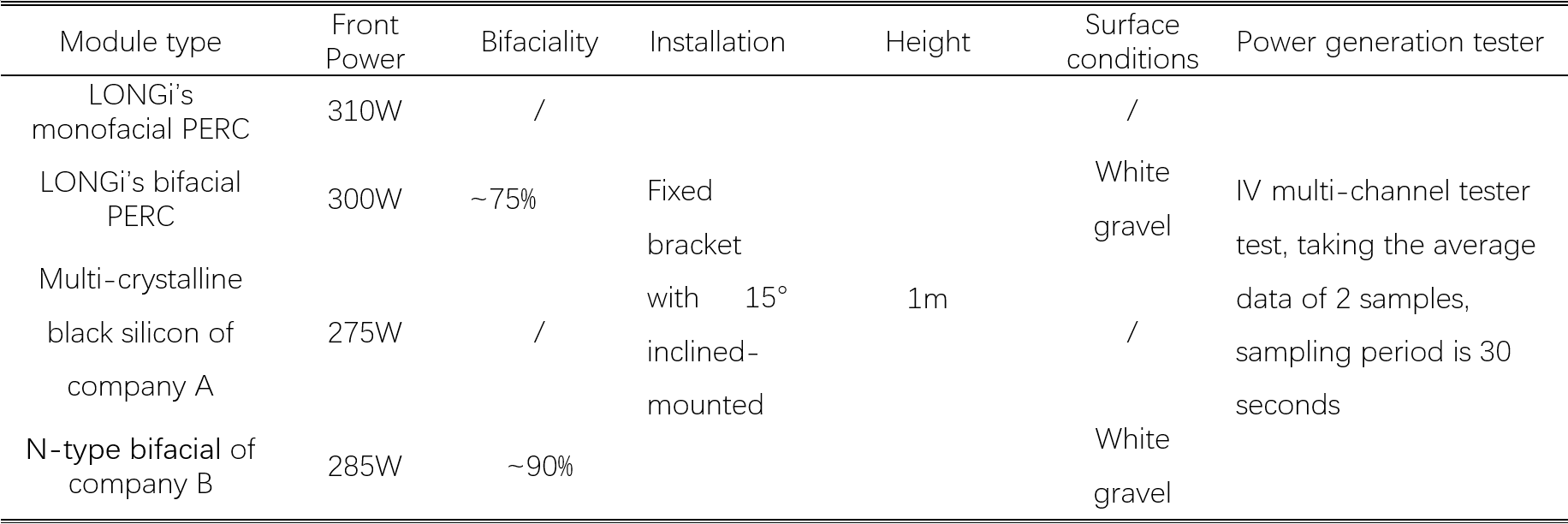1)Project information
Located in Chennai, east coast of India with tropical wet and dry climate, specific information of the pilot project is shown in the below picture.

This pilot project used 2 modules for each type and installed in the same row with a total of 8 modules. The 4 types of modules are: LONGi’s monofacial PERC module, LONGi’s bifacial PERC module (with frame), multi-crystalline black silicon module of company A, N-type bifacial module of company B (without frame). All the modules are fixed bracket with 15° inclined-mounted and 1m high above the ground. All the 4 bifacial modules are paved with white gravel, as shown in the figure below:



2)Power generation performance of four type modules
The power generation of the four type modules from September 2018 to February 2019 is shown in Figure 3: Compared with PERC monofacial modules, the power generation gains of the PERC bifacial modules and N-type bifacial modules are respectively 19.21% and 20.12% due to the increased rear-side power generation, the N-type bifacial modules are slightly higher than P-type bifacial modules by 0.76%, and the difference is mainly caused by the edge of the frame through analysis (The theoretical calculation of the framed module will be about 1% less due to the partial shaded compared with the frameless module), if the effect of the frame is removed, the power generation capacity of the two is basically the same (the bifacial module with frame has obvious advantages in long-term reliability, analysis article will be followed); the multi-crystalline black silicon module generates 3.05% less power than the monofacial PERC module, which is derived from the superior power temperature coefficient and low irradiance performance of the monocrystalline PERC module. Correspondingly, the power generation gain of the PERC and N-type bifacial relative to the multi-crystalline modules reaches 22.96% and 23.90%. According to the test of TÜV Rhein, the power temperature coefficients of the LONGi PERC monofacial and bifacial modules are -0.347%/C and -0.363/C, and the multi-crystalline black silicon modules are 0.400%/C. According to the monthly data, the power generation gain is generally stable. Due to the power breakage in October 2018, the power generation gain is lower than the normal value.

3) Correlation of power generation gain, rear side irradiation and scattering ratio

Figure 4 shows the correlation of the power generation gain of the PERC bifacial module, rear side radiation gain and scattering ratio for a period of time. It can be seen that the power generation gain is significantly correlated with the data of backside radiation gain and the scattering ratio. The higher ratio of solar radiation scattering, the higher ratio of the backside irradiation to the frontal irradiation of the module, and the higher power generation gain of the bifacial module.

Then we selected a clear day to show the difference between the power generation gain and the scattering ratio in different time periods. It can be seen that the power generation gain of the PERC bifacial modules during the day is relatively stable, due to the high proportion of scattered light in the morning and evening, the curves of the two power generation gain tilted up.

4) Performance Ratio

In summary, in the tropical monsoon climate on the east coast of India, LONGi’s monofacial PERC module generates more than 3% of the power generation of the multi-crystalline black silicon module, the energy gain of P-type PERC bifacial and N-type bifacial module can reach more than 20% of multi-crystalline black silicon module on the white gravel surface condition. The power generation performance of P-type bifacial PERC module and the N-type bifacial module with higher bifaciality are at the same level, however the cost of P-type bifacial PERC is more competitive than N-type bifacial. With the expansion of production capacity and cost of monocrystalline PERC cells and modules decrease, PERC modules will soon dominate in the Indian PV market.